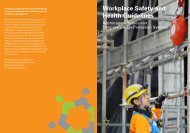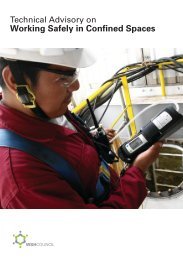Code of Practice - Workplace Safety and Health Council
Code of Practice - Workplace Safety and Health Council
Code of Practice - Workplace Safety and Health Council
Create successful ePaper yourself
Turn your PDF publications into a flip-book with our unique Google optimized e-Paper software.
SECTION 6:<br />
EMERGENCY AND CONTINGENCY PLANNING<br />
6.1 General<br />
6.1.1 All lifting operations shall have a documented Emergency Response Procedure (ERP) that<br />
covers all aspects <strong>of</strong> the operations. The ERP identifies in a clear <strong>and</strong> precise manner the<br />
requirements <strong>and</strong> actions to be carried out for any foreseeable emergency (with or without any<br />
casualty). These include:<br />
• toppling <strong>of</strong> the lifting equipment;<br />
• structural failure <strong>of</strong> the lifting equipment such as boom fracture;<br />
• dislodgement <strong>of</strong> the suspended load;<br />
• entanglement <strong>of</strong> load with nearby structures; <strong>and</strong><br />
• recovery <strong>of</strong> injured personnel in locations where access is limited such as within a tower<br />
crane.<br />
6.1.2 The ERP must include the emergency contact details <strong>of</strong> relevant persons <strong>and</strong> agencies. The<br />
contingency procedure should outline all possible emergency situations <strong>and</strong> identify the recovery<br />
actions to be taken if they occur.<br />
6.1.3 The documented procedures shall be tested by conducting ERP drills involving all lifting<br />
operation personnel. Such ERP drills must be documented <strong>and</strong> recorded as part <strong>of</strong> the safe system for<br />
work. The drills may be conducted as a desk top review which includes all relevant personnel in the<br />
table top exercise. However, a physical exercise <strong>and</strong> drill should be carried out whenever possible.<br />
6.2 Emergency Response Procedures<br />
6.2.1 The contractor shall develop <strong>and</strong> document an ERP for the lifting operation. This ERP must be<br />
communicated to all personnel involved in the lift <strong>and</strong> made available at prominent locations at the<br />
workplace. The ERP shall include but not be limited to:<br />
• details <strong>of</strong> emergency personnel <strong>and</strong> their contacts including first-aiders;<br />
• emergency communication flowchart;<br />
• roles <strong>and</strong> responsibilities <strong>of</strong> the emergency management team;<br />
• emergency services contact details;<br />
• managing injured persons; <strong>and</strong><br />
• frequency <strong>of</strong> exercise <strong>and</strong> drill to be carried out.<br />
6.2.2 Lifting operations may be carried out from the ground level or at a high point such as on the<br />
top <strong>of</strong> a multi-storey building or in confined areas such as in a tunnel or factory. Each location provides<br />
specific challenges for the provision <strong>of</strong> medical <strong>and</strong> evacuation support. As such, the ERP should as<br />
much as possible identify access to the location so as to facilitate expeditious medical <strong>and</strong> evacuation<br />
support.<br />
Page 25 <strong>of</strong> 38

















